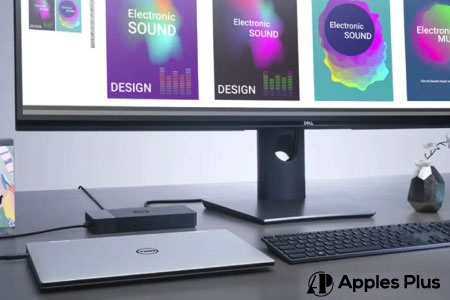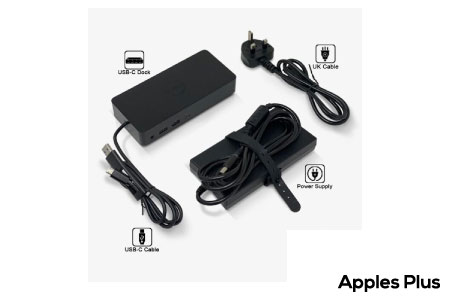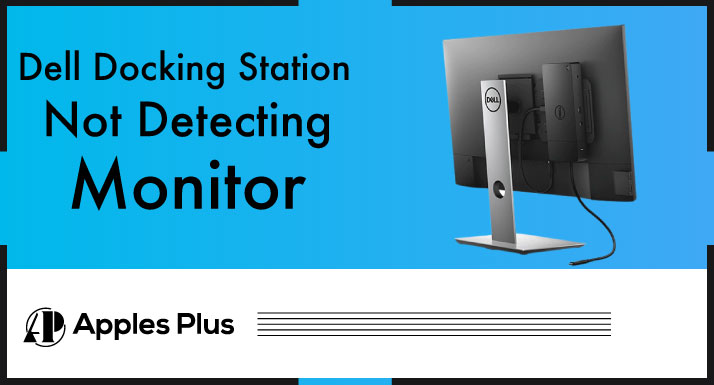A Dell docking station is a helpful device that connects multiple peripherals, such as a monitor, keyboard, and mouse, to their laptop.
However, sometimes the docking station may not detect the monitor, preventing the user from utilizing its full capabilities. This can be a frustrating experience for users, especially those who rely on multiple displays for their work.
In this blog post, we will explore some common reasons why a Dell docking station may fail to detect a monitor and provide some troubleshooting steps to help resolve the issue.
Why Dell Docking Station Not Detecting Monitor?

There could be several reasons why a Dell docking station is not detecting a monitor. Here are a few things you can check:
1. Compatibility
Compatibility is an important factor to consider when using a docking station. Docking stations are designed to work with specific laptops and monitors, and using an incompatible docking station can cause issues like not detecting the monitor. Here are some things to keep in mind regarding compatibility:

- Laptop compatibility: The first thing to check is if the docking station is compatible with your laptop. Most docking stations are designed to work with specific models of laptops. Ensure your laptop is consistent with the docking station you are using.
- Monitor compatibility: Check if the docking station is compatible with your monitor. Ensure the docking station has the necessary ports to connect to your monitor. For example, if your monitor has an HDMI port, ensure the docking station has an HDMI port.
- Compatibility with the operating system: Check if the docking station is compatible with the operating system on your laptop. Ensure that the docking station is consistent with the version of Windows or macOS you are using.
- Power requirements: Check the power requirements of the docking station to ensure that it is compatible with the power supply in your country. Some docking stations may require a specific voltage, and using the wrong power supply can cause issues.
- Firmware compatibility: Check if the firmware of the docking station is up-to-date. Outdated firmware can cause compatibility issues. You can check for firmware updates on the Dell website.
If you need clarification on the compatibility of the docking station, check the documentation that came with the docking station or contact Dell customer support for assistance. They will be able to provide you with the necessary information and help you find a compatible docking station if needed.
2. Cable Connection
The connection between the docking station and the monitor is essential to ensure that the monitor is detected and working correctly. Here are some things to keep in mind regarding cable connection:

- Use the correct cable: Make sure you use the correct cable to connect the monitor to the docking station. The type of cable you need will depend on the ports available on the docking station and the monitor. Some common types of monitor cables include HDMI, DisplayPort, DVI, and VGA. Check the ports on your docking station and monitor and use the appropriate cable.
- Check for damage: Inspect the cable to ensure it is not damaged. Look for any signs of fraying, cuts, or damage to the connectors. A damaged cable can cause issues like a weak or intermittent connection or no connection at all. If the cable is damaged, replace it with a new one.
- Securely plug in the connectors: Make sure that the connectors on the cable are securely plugged into the docking station and the monitor. A loose connection can cause issues like flickering or no display. Make sure that the connectors are inserted fully and securely.
- Check the docking station port: Ensure that you are plugging the cable into the correct port on the docking station. The docking station may have multiple ports, and some may not support the monitor. Check the docking station manual to determine which port to use for the monitor.
- Check the monitor input: Ensure the monitor is set to the correct input. The input setting may need to be changed if the monitor is not receiving a signal from the docking station. Change the input setting using the monitor’s buttons or the on-screen menu.
By following these steps, you can ensure that the cable connection between the docking station and the monitor is correct and the monitor is detected and working correctly.
3. Power Supply
The power supply is an essential component of a docking station. It provides the necessary power to the docking station and any connected devices like a monitor. Here are some things to keep in mind regarding the power supply:

- Check the power source: Ensure the docking station is plugged into a working power outlet. The docking station will not receive power if the power outlet is not working. You can test the power outlet using another device.
- Verify the power cord: Make sure that the power cord is plugged into the docking station and the power outlet correctly. The power cord should fit snugly into the docking station and outlet. Check the cord for any signs of damage like fraying, cuts, or cracks.
- Check the LED indicator: Many docking stations have an LED indicator that shows if the docking station is receiving power. Check the LED indicator to ensure that the docking station is receiving power. If the LED indicator is not lit up, the docking station is not receiving power.
- Check the power button: Some docking stations have a power button. Make sure that the power button is turned on. The docking station will not receive power if the power button is turned off.
- Verify the power requirements: Check the power requirements of the docking station. Ensure that the docking station is compatible with the power supply in your country. Some docking stations may require a specific voltage or wattage, and using the wrong power supply can cause issues.
By following these steps, you can ensure that the power supply to the docking station is correct and the docking station is receiving power. If the docking station still does not detect the monitor, you may need to try other troubleshooting steps.
4. Driver Issue
Driver issues can cause problems with the docking station and prevent it from detecting the monitor. Here are some things to keep in mind regarding driver issues:

- Check the device manager: Open the device manager on your laptop and look for any devices with a yellow exclamation mark next to them. This symbol indicates that there is an issue with the driver. If you see any devices with this symbol, right-click on the device and select “Update Driver Software” to update the driver.
- Install the correct driver: Ensure you have installed the correct driver for the docking station. You can download the latest drivers from the Dell website. If you need help determining which driver to install, check the documentation that came with the docking station.
- Uninstall and reinstall the driver: Reinstalling the driver can sometimes fix issues with the docking station. To uninstall the driver, open the device manager, right-click on the docking station, and select “Uninstall.” Once the driver is uninstalled, restart your laptop and reinstall the driver.
- Check for firmware updates: Firmware updates can sometimes fix driver issues with the docking station. Check the Dell website for any firmware updates for the docking station.
- Try a different USB port: If you use a USB docking station, try plugging it into a different one. Sometimes, USB ports can stop working correctly, and plugging the docking station into a different port can fix the issue.
By following these steps, you can troubleshoot driver issues with the docking station and fix any problems preventing it from detecting the monitor. If you are still experiencing issues, you may need to contact Dell customer support for further assistance.
5. Display Settings
Display settings can affect the ability of the docking station to detect the monitor correctly. Here are some things to keep in mind regarding display settings:

- Check the resolution: Make sure the monitor’s resolution matches the resolution set in the display settings. If the resolution is incorrect, the monitor may not display correctly, or the docking station may not detect it. You can check the resolution in the display settings in the control panel or the settings app.
- Extend or duplicate the display: Make sure that the display is set to extend or duplicate the desktop. If the display is set to “PC screen only,” the docking station will not detect the monitor. You can change the display settings by right-clicking on the desktop and selecting “Display settings.”
- Change the Refresh Rate: The refresh rate is the number of times the screen is refreshed per second. If the refresh rate is too low, the monitor may not display correctly or may not be detected by the docking station. You can change the refresh rate in the advanced display settings.
- Update the Graphics Driver: A graphics driver issue can cause problems with the display settings. Make sure that you have installed the latest graphics driver for your laptop. You can download the newest driver from the manufacturer’s website.
- Check for Multiple Displays: Sometimes, a laptop can detect multiple displays, and the docking station may be set to display on a different monitor. You can check the settings to ensure the correct display is selected.
Following these steps, you can troubleshoot display settings issues with the docking station and ensure the monitor is detected correctly. If you are still experiencing problems, you may need to contact Dell customer support for further assistance.
Frequently Asked Questions (FAQs)
Why won’t my Dell docking station detect my monitors?
A Dell docking station may fail to detect a monitor due to compatibility issues or cable connection issues.
How do I get my monitor to work with my Dell docking station?
To get your monitor to work with your Dell docking station, check the compatibility and cable connections, update drivers and firmware, and adjust display settings.
How do I get my monitor to recognize my docking station?
To get your monitor to recognize your Dell docking station, make sure that the cables are connected properly, the display settings are configured correctly, and the drivers are up to date. Additionally, check for compatibility issues between your monitor and docking station model.
Conclusion
In conclusion, a Dell docking station not detecting a monitor can be frustrating for users who rely on multiple displays for their work.
However, by following basic troubleshooting steps, such as checking compatibility, cable connections, and display settings, users can often resolve the issue and get their monitor to work with their docking station. If the problem persists, it is recommended to seek assistance from Dell customer support for further help and guidance.

Meet Harry, the author of Apples Plus! Harry is a highly skilled electronic engineer passionate about testing and reviewing tech products like monitors and soundbars. With years of experience in the industry, Harry has developed a keen eye for detail and an in-depth understanding of the latest tech trends and developments.


